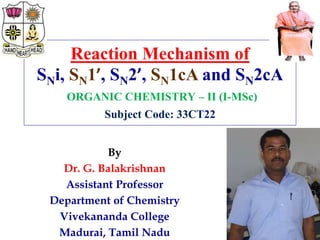
Reaction Mechanism of SNi, SN1’, SN2’, SN1cA and SN2cA reaction
- 1. Reaction Mechanism of SNi, SN1’, SN2’, SN1cA and SN2cA ORGANIC CHEMISTRY – II (I-MSc) Subject Code: 33CT22 By Dr. G. Balakrishnan Assistant Professor Department of Chemistry Vivekananda College Madurai, Tamil Nadu
- 2. SNi –Mechanism (substitution nucleophilic internal) In a few reactions, nucleophilic substitution proceeds with retention of configuration, even where there is no possibility of a neighboring-group effect. In the SNi mechanism, part of the leaving group must be able to attack the substrate, detaching itself from the rest of the leaving group in the process. The first step is the same as the very first step of the SN1 mechanism dissociation into an intimate ion pair. But in the second step part of the leaving group attacks, necessarily from the front since it is unable to get to the rear, which results in retention of configuration.
- 3. The SNi mechanism is relatively rare. Another example is the decomposition of (alkyl chloroformates) ROCOCl → RCl + CO2
- 4. SN1’ Reaction When allylic substrates are treated with nucleophiles under SN1 conditions, two products are usually obtained: the normal one and a rearranged one. This reactant should give the same mixture of alcohol when reacting with NaOH, Since carbocation (C+) form each should be the same. NaOH 40%Yield : 60% CH3-CH=CH-CH2Cl → CH3-CH=CH-CH2-OH + CH3-CH(OH)-CH=CH3
- 5. Two products are formed because an allylic type of carbocation is a resonance hybrid. First step, the reactant give rise to two different intimate ion pairs. And than second, the field of the anion polarise the allylic cation, making the nearly carbon atom more electrophilic, so that it has a greater change of attracting the Nucleophile. SN1’ Reaction ….
- 6. SN2’ Reaction Nucleophilic substitution at an allylic carbon can also take place by an SN2 mechanism, in which case no allylic rearrangement usually takes place. However, allylic rearrangements can also take place under SN2 conditions, by the following mechanism, in which the nucleophile attacks at the -carbon rather than the usual position (called SN2’).
- 7. The stereochemistry of SN2’ reactions has been investigated. It has been found that both syn and anti reactions can take place, depending on the nature of X and Y, Although the syn pathway predominates in most cases. SN2’ Reaction ….
- 8. SN1cA (Nucleophilic Substitution Unimolecualr Conjugate Acid) Reactions in which the leaving group does not come off (labile) until it has been protonated have been called SN1cA or SN2cA, depending on whether after protonation the reaction is an SN1 or SN2 process. Ex: -OH and -OR are not leaving groups from ordinary alcohols and ethers, but can come off when the groups are protonated, that is, converted to ROH2 + Or RORH+.
- 9. Here alkoxyl group -OR is not a leaving group, so these compounds must be converted to the conjugate acids before they can be hydrolyzed. Although 100% sulfuric acid and other concentrated strong acids readily cleave simple ethers, the only acids used preparatively for this purpose are HBr and HI. These compounds (acetals/ketals/ester)are hydrolyzed with greater facility because carbocations of the type RO-CH- are greatly stabilized by resonance. The above reactions therefore proceed by the SN1 mechanism, as shown for acetals as a product. SN1cA…..
- 10. In general SN2 mecanism there is backside attack, the nucleophile approaches the substrate from a position 180o away from the leaving group. The reaction is a one-step process with no intermediate. In SN2cA mechanisms, there is a preliminary step, the addition of a proton, before the normal SN2 process occurs. SN2cA (Nucleophilic Substitution Bimolecular Conjugate Acid)
- 11. It is obvious that the best nucleophiles (e.g., -NH2 , -OH) cannot take part in SN1cA or SN2cA processes, because they would be converted to their conjugate acids under the acidic conditions necessary to protonate the leaving groups. Because SN1 reactions do not require powerful nucleophiles, but do require good leaving groups, most of them take place under acidic conditions. In contrast, SN2 reactions, which do require powerful nucleophiles (which are generally strong bases), most often take place under basic or neutral conditions. SN2cA…..
- 12. Reference book: MARCH’S ADVANCED ORGANIC CHEMISTRY, 6th edition
